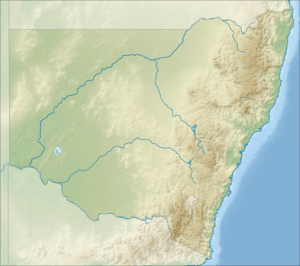Mole River (New South Wales)
| Mole | |
| The Mole River[1] | |
| River | |
| Country | Australia |
|---|---|
| State | New South Wales |
| Region | Northern Tablelands |
| Part of | Macintyre River catchment, Murray–Darling basin |
| Source confluence | Deepwater River and Bluff River |
| - location | west of Sandy Flat |
| - elevation | 614 m (2,014 ft) |
| - coordinates | 29°13′08″S 151°56′48″E / 29.21889°S 151.94667°E |
| Mouth | confluence with the Pike Creek to form the Dumaresq River |
| - location | near Mole River (settlement) |
| - elevation | 363 m (1,191 ft) |
| - coordinates | 28°59′47″S 151°31′03″E / 28.99639°S 151.51750°ECoordinates: 28°59′47″S 151°31′03″E / 28.99639°S 151.51750°E |
| Length | 73 km (45 mi) |
 Location of Mole River mouth
in New South Wales | |
| [2] | |
The Mole River, a watercourse that is one of the Border Rivers and part of the Macintyre catchment within the Murray–Darling basin, is located in the Northern Tablelands region of New South Wales, Australia.
Course and features
Sourced from the western slopes of the Great Dividing Range, the river rises at the confluence of Deepwater River and Bluff River, west of Sandy Flat, and flows generally to the west before reaching its confluence with the Dumaresq River, near the village of Mole River; descending 252 metres (827 ft) over its 73 kilometres (45 mi) course.[2]
The Mole River is one of the remotest headwaters of the Murray-Darling basin; and the area drained is hilly and rocky.
In 2007, Tenterfield Shire Council called for a dam to be constructed on the Mole River.[3]
See also
References
- ↑ "Mole River". Geographical Names Register (GNR) of NSW. Geographical Names Board of New South Wales. Retrieved 5 February 2013.
- 1 2 "Map of Mole River, NSW". Bonzle Digital Atlas of Australia. Retrieved 5 February 2013.
- ↑ Barker, Tony (25 October 2007). "Council calls for Mole River Dam". Tenterfield Star. Retrieved 22 December 2007.
External links
- "Border Rivers catchments" (map). Office of Environment and Heritage. Government of New South Wales.